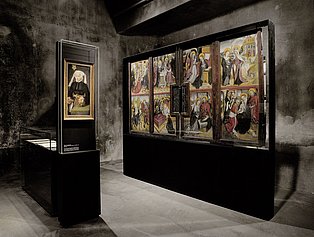
The pre-modern collection is one of the Ruhr Museum's oldest collections. Its history goes back to the founding of the museum, when the citizens of the city of Essen set out to collect the relics of a world threatened by industrialisztion and to reassure themselves of their traditions and identities. In this respect, the pre-modern collection is also, at least in its origins, the most regional, indeed the most local of the museum. It is most closely associated with the concept of "home", conveys familiarity and belonging and was shown for decades in the "Ruhrland- und Heimatmuseum" of the city of Essen. In a way, however, the pre-modern collection is also the museum's most foreign. It contains objects that are no longer familiar to us due to the temporal distance to their origin, their function and their context of meaning and take on the character of ethnological pieces, as evidence of cultures that are not spatially but temporally distant. In this respect, the pre-modern collection of the museum embodies the two categorical possibilities of the museum at the same time: it is an offer of identification and a heterotope in one.
The pre-modern collection is also the museum's most heterogeneous. It reflects the museum's chequered history of over a hundred years, was only systematically assembled in short phases, has had to cope with perhaps the greatest losses and was severely decimated, especially during the Second World War. For this reason, only a small number of closed collections, systematic series or meaningful comparative pieces exist. In most cases, these are individual pieces, but from a wide variety of genres, functions and uses from the Early Middle Ages to the end of the Early Modern period on the eve of industrialization.
And finally, the pre-modern collection is one of the Ruhr Museum's most valuable. On the one hand, this is due to the material and art or cultural-historical value of the individual pieces, but it also applies in a figurative sense. Since the view of the regional history of the Ruhr area has increasingly expanded beyond the period of industrialization to more distant epochs, the pre-modern collection has increasingly become a nucleus for new questions. The Ruhr(land)Museum has repeatedly addressed this period in numerous special exhibitions on medieval and early modern history over the past two and a half decades and in its Permanent Exhibition at Zollverein.
Part of the Pre-modern Collection can be seen in the Ruhr Museum's Permanent Exhibition.
Large parts of the Pre-modern Collection can now be seen in the Schaudepot as part of a guided tour.